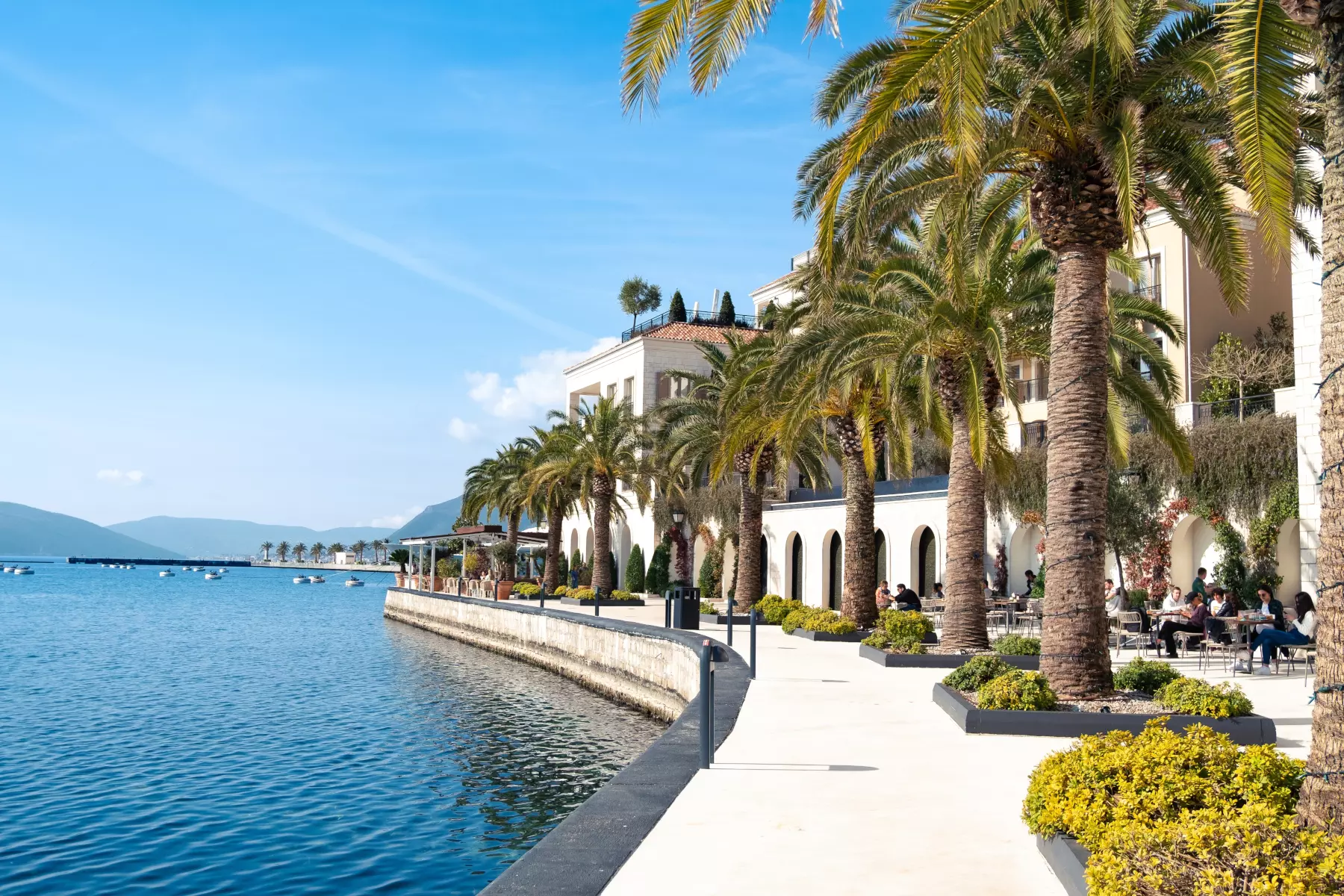About Montenegro
Quick Facts
Surface area: 13,812km2
Population: 670,000
Coastline: 294km
Beaches: 117 in total (73km)
Highest point: 2.522 m (Durmitor, Bobotov kuk)
Climate: Mediterranean on coast, Continental inland
Sunshine: Average 240 days per year
Language: Montenegrin (very similar to Serbian and Croatian), English and Russian widely spoken
Currency: Euro
Main Cities: Podgorica (capital), Bar, Cetinje, Niksic, Herceg Novi, Budva, Kotor
Political system: Republic, (Independent State from May 2006). The Republic of Montenegro was admitted as a Member of the United Nations by General Assembly resolution 60/264 on 28 June 2006.
Electricity: 220V
International country code: +382
Time Zone: +1 GMT (+2 in summer)
Flying time: 2-3 hours from most captial cities in Europe
Airports: Podgorica, Tivat, and Cilipi (Dubrovnik) in Croatia, 14 km from border
Ports: Bar, Budva, Kotor and Herceg Novi
List of public holidays in Montenegro:
- 1 Jan – New Year’s Day
- 7-8 Jan – Orthodox Christmas Day
- 1-2 May – Labour Days
- 21-22 May – Independence Day
- 13-14 Jul – Statehood Day
Easter and Christmas holidays are also celebrated
Please note that each holiday lasts two days, and if the holiday starts on a Sunday then both Monday and Tuesday are holidays.
Location
Montenegro is a small, but very mountainous country on the Adriatic coast, between Croatia and Albania and opposite Puglia, the heel of Italy. Montenegro is very accessible being less than 3 hours flight from most of Europe and Russia. There are two main airports; Tivat and Podgorica, but many travellers also use Dubrovnik airport in Croatia, which is just 14km from the Montenegro border. For details of flights in your area, please contact us.
Natural Beauty
You may think we’re biased but we believe that Montenegro is one of the most beautiful countries in the world. However, we are not the only ones. Back in 19th century, Lord Byron wrote “At the birth of our planet, the most beautiful encounter between the land and the sea must have happened at the coast of Montenegro. When the pearls of nature were sown, handfuls of them were cast on this soil.” Montenegro still retains its natural charm and beauty. Architecture dating back to the 12th Century is still prevalent among the many UNESCO heritage towns and villages. Montenegro’s natural beauty is dramatic; mountains dropping down to mirrored water in the UNESCO heritage Kotor bay and the crystal clear waters of the Adriatic lapping the sandy beaches of the coast. Although the gulf of Kotor is commonly referred to as a fjord, it was not formed by glacial movement and is in fact a ria (a drowned river canyon), but is by common consent, spectacular. Drive into the mountains to find undrowned river canyons (the Tara canyon being the second deepest in the world), glacial lakes, untouched nature and a fledgling ski and eco-tourism industry. On the coast, the climate is Mediterranean rising to 40 degrees in August, but cooler inland where the climate is Continental.
Regions
Budva lies at the heart of Montenegrin tourism, with a beautifully preserved old town and fantastic beaches. As well as the pretty islands in the bay and it’s stunning sandy beaches, Budva is rich in history. The Old Town lies on a small peninsula and represents a treasure chest of cultural heritage. The Budva coast itself is 21 km long with no less than 17 beaches, and includes, Sveti Stefan, certainly the most iconic place in Montenegro. Originally a fishing village, the island is now a 5 star hotel run by Aman Resorts, connected to the mainland beaches by a narrow sand spur. Further south is Petrovac, a beautiful coastal town located approximately half way between the towns of Budva and Bar.
Herceg Novi is one of the sunniest towns on the coast, and has a pretty little old town at its centre. Full of lush greenery, Herceg Novi hosts numerous types of tropical flowers. Towards the end of January the town becomes scented with the subtle fragrance of yellow and green mimosas; the festival of Praznik Mimosa is dedicated to this flower. During the summer months many festivals further enrich the tourist attraction of this busy town.
The Bay of Kotor is undoubtedly one of the most beautiful bays in the world. High mountains encircle the bay and are reflected in the deep blue waters of the Adriatic Sea. Seven islands decorate the Bay of Kotor, adding intrigue. The road hugging the Bay of Kotor passes though a chain of villages, many of which are rich in cultural heritage. Risan is the oldest settlement in the Kotor Bay, and has Roman mosaics dating back to the 3rd century. Kotor and Perast are beautifully preserved medieval towns, classified by UNESCO as world heritage sites.
Tivat is located in the central part of the Boka Kotorska bay. A young town with a pretty waterfront, it’s a firm favourite for yacht enthusiasts. The main airport for the Montenegrin coast is a short drive from the town. Porto Montenegro, the largest super yacht marina in Europe, is located in Tivat. The Lustica peninsula is an unspoiled area of oustanding natural beauty with olive groves, sleepy countryside and dozens of authentic fishing villages and beaches in peaceful bays. The largest towns on the peninsula are Krasici and Radovici, well known for the gently sloping and family friendly Blue Horizon beach. Lustica is also the site of the new Lustica Bay Project, which is now under-construction. Lustica Bay is a ground-breaking, environmentally friendly and sustainable village, marina and golf course complex that is attracting worldwide attention.
Bar is the second largest city in Montenegro (after Podgorica, the capital). It is a vibrant port and new town about 40 minutes drive from Podgorica airport with different architectural styles, modern squares, coastal promenades and wide boulevards with a variety of Mediterranean plants such as palms, pines, oleanders and agaves. Overlooking the new town is a beautiful old town with an ancient archeological site. Ulcinj is the southernmost city on the Montenegrin coast and boasts the longest beach on the Adriatic sea, the Velika Plaza is 13 km long. To the south of this beach, lies Ada Bojana, a naturist river island with marvellous sandy beaches. Valdanos is a unique bay with a coastline covered in old olive trees close to the reconstructed old city of Ulcinj which is full of interesting restaurants, cafés, art galleries and hotels.
Podgorica is the vibrant capital city with rail and airport links to many other European cities. Cetinje is the old capital, with plenty of historical architecture. Lake Skadar is the largest freshwater lake in the Balkans, a national park, its teeming with wildlife and is a favourite with birdwatchers.
Zabljak and Kolasin are the main skiing resorts in Montenegro. Zabljak is a pretty mountain town at 1450m above sea level, in the centre of Durmitor National Park. Durmitor is a favourite with skiers and white water rafters for its dramatic natural beauty, mountains and lakes, and of course, Tara Canyon, the deepest gorge in Europe. Kolasin is a small town in the centre of Montenegro, near the popular ski resort of Bjelasica. Bianca Resort and Spa is a newly refurbished 5 star hotel in the centre of town. The natural beauty of Biogradska Gora National Park is just 15 minutes drive away.
Economy
Montenegro has started EU accession discussions and is expected to join within the next 5 years. Montenegro has a stable economy, having adopted the Euro as its currency in 2001. The global recession affected Montenegro, but has coped relatively well due to the size of the country and the amount of incoming investment.
Tourism
Montenegro was largely ignored as a tourist destination after the Balkans conflict but is starting to be rediscovered. The World Travel and Tourism Council has rated Montenegro to be one of the top two fastest growing tourism economies over the next 10 years. There is a shortage of western-standard hotel and residential accommodation. The people are friendly and welcoming (although it has to be said, very tall!) The locals are very appreciative of foreigners investing in their country. On sampling the local cuisine, you will find it very fresh, natural and typically Mediterranean. English is widely spoken.
Infrastructure
Infrastructure is rapidly improving with many projects ongoing being funded by the state, the EU, Russia and the US. New roads, electricity, water and waste networks have been greatly improved in the last couple of years. Despite the global credit crisis, Montenegro has continued to attract funding and many infrastructure projects are continuing unabated. The quality of building construction has greatly improved in the last few years and a number of high quality, high profile projects are currently being built or in the planning process.
Property Market
The property market started to attract foreign investors in 2005 and some areas doubled in value by 2007. The recession has dropped prices back to 2006 levels and so offers great value for better quality property with improved infrastructure and rental yields. Unlike other countries, investors have come from many different countries and no one country seems to be overly represented. For up to date information about the property market, please contact us for a general or regional report.

